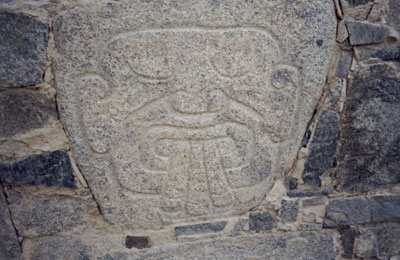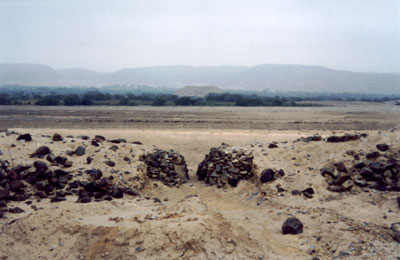|
|
|
|
| |
 Cerro
Sechín Cerro
Sechín
From Casma, we were able to view some Initial
Period sites, including Cerro Sechín, Sechín Alto, Chanquillo, and Pampa
de las Llamas. Cerro Sechín is the small square-shaped site with battle
scenes carved into the exterior of its stone walls. These gruesome scenes
included decapitations, amputations, bodies cut apart at the torso, victorious
warriors, trophy heads, and more. The site coincides with Sechín Alto,
but the large Pampa de las Llamas site was also a force in the Casma Valley
at the same time. The mystery of Cerro Sechín is whether the carvings
are religious or whether the site is a battle memorial. If it is a memorial,
then who were the victors and losers? At this time, only three of four
walls are excavated, and the structures within those walls also need to
be excavated. |
|
| |
|
|
| |
Chanquillo
The site of Chanquillo, perched on a
small hill in the middle of the desert, consisted of three massive stone
wall rings around a small ceremonial center in the middle. The walls
were constructed so that if you went in one doorway, you had to walk
halfway around the outer circle to pass through the next wall, and so
on. Thus, the site was easily defended and access easily restricted.
From conversations with an astronomical archeologist working at the
adjacent site, from the same time period, we learned that Chanquillo,
the buildings below, the thirteen steps, and more buildings on the far
side of the steps, are all likely related as one large site. Lines could
be drawn from the centers of the circles on Chanquillo, through the
steps, to corners or rooms in buildings below such that they aligned
with important lunar and solar events. I do not believe this is a case
where something is conveniently being made of coincidences, since all
the construction seemed very similar… loosely fitted stones occasionally
supported by wooden planks. It will be interesting if the archeological
team there is successful in using dendrochronology to date the site.
Regardless, the thirteen steps are a series of rock mounds built on
a low ledge beneath Chanquillo. Each of them has a small staircase one
can use to climb to the top, and they have never been accurately dated.
|
|
| |
|
|
| |
 Pampa
de las Llamas Pampa
de las Llamas
Huaca A, Moxeke, the intermediate mounds, and
surrounding structures combine to make Pampa de las Llamas, and intriguing
Initial Period site with a powerful corporate authority. Huaca A is
a mound built of stone with several levels of symmetrical storage rooms
rising up from the center of the mound. As one goes upwards and inwards,
access is more and more restricted. Curiously, square spaces were converted
to have rounded corners, wasting the space between the curve and the
corner. Also interesting, the line of symmetry for Huaca A points directly
at the center of Moxeke, a large temple mound. Intermediate mounds,
composed of rooms of similar size and shape as the ones on Huaca A,
flank a large plaza between the two large mounds. Opposite the side
of Moxeke from Huaca A, a sunken circular court has been lost to the
last El Niño. The evidence for a strong corporate authority, especially
for Initial Period times, is the sheer amount of workforce it would
take to build two mounds of that size out of stone, in addition to the
extremely restricted access on Huaca A, and the social stratification
between the people who ruled from the mounds, the people who lived in
the intermediate mounds nearby, and the common people.
|
|
| |
|
|
| |
Sechín
Alto
Finally, we came to visit Sechín Alto,
one of the largest mound structures yet. Also from the Initial Period,
Sechín Alto's core was constructed of large cone-shaped adobe bricks,
possibly in the shape of a cross. On top and surrounding this, the rest
of the mound was built with stones, similar to Pampa de las Llamas and
Chanquillo. Personally, I think the core could be any number of shapes,
and archeologists have just happened to discover sections that apply
to a cross-shape. Either way, little work has been done there, and archeologists
had just found a midden associated with the structure this summer. To
further confuse matters, the top of Sechín Alto has been occupied by
other cultures after the Initial Period. Either way, it remains a testament
to the wealth of the Casma Valley in Initial Period Peru.
|
|
| |
|
|